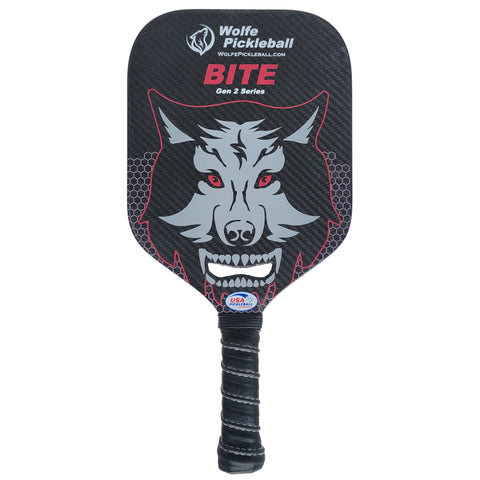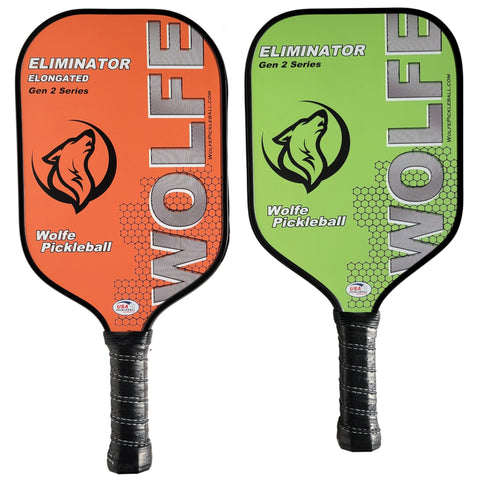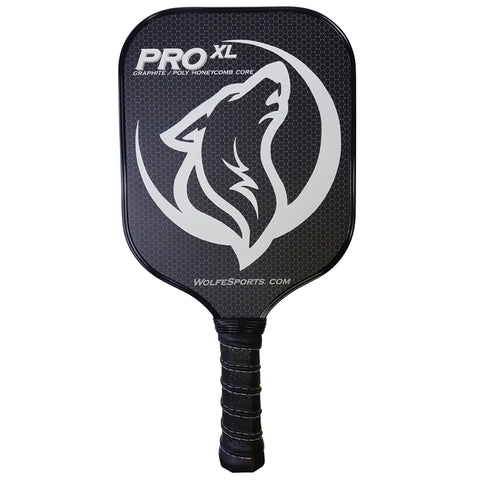Pickleball Paddles
Pickleball is meant to be enjoyed by those of all ages. As such, the rules of the game are fairly straightforward. Along those same lines, you don't need a great deal of equipment in order to play. For the most part, it all boils down to having the right type of ball for your venue and a regulation pickleball paddle made to suit you. Though finding a paddle seems simple enough, you'll notice a wide range of options on the market. At Wolfe Sports, we offer enthusiasts an assortment of gear and help them choose which will best serve their needs.
Paddle Basics
Practicing, honing your skills, and learning a few tricks are all important factors in any game. When it comes to this particular sport, though, it's safe to say your paddle has as much of an impact on your proficiency as overall talent. One of the most significant aspects to consider is structure, and pickleball paddles come in a variety of material combinations. Surface composition is usually categorized as either wood, composite, or graphite, also known as carbon fiber.
Beneath the surface lies a core sometimes made of an entirely different material. Some are fashioned from multiple layers of wood, whereas others are composite. Much like composite outer layers, these are usually a blend of resin, fiberglass, and carbon fiber. You'll also find polymer, aluminum, and Nomex honeycomb cores. Each combination of surface and core makeup gives you different results.
How Do Materials Factor into the Equation?
From a technical standpoint, material determines the weight of the pickleball paddle. In turn, this has a way of affecting your game. Paddle weight ranges from six to 14 ounces. Though even the heaviest versions weigh in at less than a pound, imagine how heavy those 14 ounces will feel after an hour of constant swinging and repetitive ball impacts. Wood paddles are the most substantial. While their extra weight puts more gusto behind your shots, it also takes a bit more effort to control.
Composite pickleball paddles fall on the other end of the spectrum. They're lighter and give you more control over the trajectory of the ball, but the power behind your shots comes mostly from your own strength. Some players go for composite just for the satisfying pop it makes when it comes in contact with the ball. Carbon fiber is considered top-of-the-line, giving you a bit of the best of both aspects.
All this brings us to the core of the matter. Polymers add little weight to a paddle and hold up well against wear and tear. Nomex is often used with graphite hitting surfaces and is considered one of the strongest in comparison to its weight. Aluminum and composite offer similar strength as well as weight and durability.
Aside from the actual play-related factors, an obvious price difference exists among all these options. Wood is the least expensive with composite coming in second place and graphite topping out the price bracket. As far as core materials go, Nomex drives up the cost of a pickleball paddle more so than its counterparts.
Don't Be Bound by Misconceptions
Novices and experienced players alike often feel impeded by the common edge guards with which the majority of paddles are equipped, but they're there for a reason. In light of all the abuse your pickleball paddle is likely to endure, it needs the extra protection these guards provide. While even the best of the best miss that sweet spot from time to time, having the rim get in the way shouldn't be a recurring issue. If it is, you might want to consider modifying your technique rather than your paddle.
Get a Firm Grip on the Situation
Grip circumferences vary by only about half an inch between the smallest and largest options available. This may seem like an insignificant margin, but it makes a big difference when it comes to how well you're able to hold onto your pickleball paddle. If the grip is too large for your hand, you'll face plenty of struggles on the court. On the other hand, if it's too small, you're going to lose a great deal of control. As a general rule, the following guide helps when choosing your grip size.
- Players more than 5' 8" tall should go with a 4 1/2" grip.
- Those falling into the mid-height range typically require 4 1/4".
- Smaller players, such as children and adults 5' tall or less fare better with 4" to 4 1/8" grips.
Still, not everyone falls into the conventional hand size parameters. In some cases, it's a simple matter of trial and error. Should the suggested circumference not work well for you, opt for the next size up or down. If you find yourself between sizes, an array of custom grips is readily available. Each one takes the size of the original grip up in 1/16" increments. Though a number of players have chosen to supplement their stock grips with electrical tape or other non-standard materials, it's not recommended.
Handle Length
Regulations state the combined length and width of a paddle can't exceed 24" and, sometimes, this means choosing between a longer handle and a larger hitting surface. Again, which option you choose depends largely on your skill and comfort level. Shorter handles give you more room for error where aim is concerned, whereas longer ones offer more swing control. They also accommodate larger hands and allow for more gripping versatility. Plenty of models basically split the difference, so it doesn't always have to be a one-or-the-other situation.
Keep Price in Mind
If you're an experienced player, know exactly what you need to stay on top of your game and intend to stick with the sport for quite some time, by all means go for the top-notch Nomex core covered in carbon fiber. You deserve it. For those who have yet to fall into their comfort zones, the composite variety is a great way to compromise on price without sacrificing the lightweight aspect. If you have the stamina and control to handle one of the wood alternatives, these are certainly the least expensive on the market. Generally speaking, there's no harm in opting for composite unless you've already found it doesn't work for you.
Is There Anything Else I Need to Know?
Aside from all those previously mentioned factors playing into your performance, a few other points need to be kept in mind. The thickness of your paddle isn't really a consideration, as the USA Pickleball Association doesn't place restrictions on this aspect. It's more a matter of your own personal preferences.
Although common logic would steer beginners and smaller people to the lightest pickleball paddles available, this isn't the best idea. Those weighing between seven and nine ounces are typically more suitable for less experienced players and those with less upper-body strength. If you've got plenty of power behind your swing, lighter paddles are appropriate, and heavier ones are great for those who can handle them.
While no set-in-stone rule prohibits you from personalizing your paddle, use caution in how you go about doing so. Highly reflective materials are frowned upon because they have the potential to blind other players. Certain add-ons, such as thick or glossy coverings, can negatively impact the performance of your paddle.
As is the case in golf or pool, giving the ball extra spin could certainly work out in your favor when playing pickleball. That being said, any English you put on it needs to come from your own power and technique. Pickleball paddle surfaces giving you any added advantage over other players are not allowed.
Though the right balls and paddles are really all the equipment you need to play the game, aside from an appropriate court, a few little extras couldn't hurt. Choose a decent pair of athletic shoes based on not only your foot features but the type of setting in which you'll be playing as well. If you divide your time between indoor and outdoor play, have a pair on hand for each surface. Quality athletic socks help thwart blisters, and comfortable, breathable clothing could only serve to enhance your performance.
Final Word
Pickleball paddles may not be the only element affecting your performance on the court, but they're definitely one of the most important. Weight is critical, and just how many ounces you need behind your swing depends on your strength, endurance, and skill. You have your choice of core and surface materials, but composite is usually the most moderately priced option and gives you a nice combination of lightness and power. It also happens to work well for the broadest range of players.
Though models without edge guards are available, whether or not a paddle has one shouldn't be the deciding factor. Choose one with the hand grip circumference based on your size, and stick with a handle length capable of allowing for the hitting surface you need. Enjoy the game, and use the right paddle as a tool in improving your skills on the court.
Browse our selection of pickleball paddles and other essentials, and let Wolfe Sports help you play at the top of your game.



